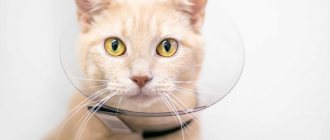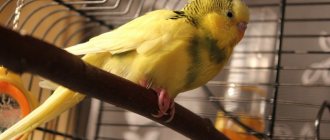Cats, like humans, sometimes experience tremors - trembling of the whole body and limbs caused by rhythmic muscle contraction. A single tremor may not cause serious concern to the owner, but it is worth knowing the possible causes of this phenomenon in order to avoid the development of dangerous pathologies. In this article, we looked at the main reasons why cats can tremble: we will tell you when trembling is harmless, and when it is an alarming symptom and indicates the development of complications. You will also learn the basic methods of diagnosis and symptomatic treatment.
Cold
Animals can freeze and are no less susceptible to hypothermia than people, so cold is the most common factor that causes tremors in a cat’s body. In this case, you can notice a slight trembling simply by placing your hand on the animal’s body. Larger tremors are visible to the naked eye.
Why does the kitten tremble and shake after water treatments? Kittens are more sensitive to high humidity and low temperatures; the thermoregulation system in their body has not yet been formed. This reaction is also characteristic of adult cats: cats tolerate low temperatures well, but can freeze and react poorly to high humidity.
IMPORTANT: monitor the room heating level. Take care of your pet by insulating its bed, use special clothing for animals.
Warmth is an important condition for a pet’s comfortable existence.
Shivering from the cold is not a cause for great concern, but prolonged exposure to low temperatures can weaken the animal and cause illness.
What causes shaking in cats?
Unless your cat has other symptoms, it can be difficult to know what's causing the shaking without a veterinary examination. Your veterinarian will use his or her experience to determine the likely cause and begin the treatment your cat needs. In addition to examining your cat, your veterinarian may ask you questions about your cat's lifestyle to help narrow down possible causes, such as:
- Their activity levels
- Number of exits
- Any scavenger hunt or hunting
Your cat's age and condition can also help determine the cause of her shaking.
© shutterstock
Here are some common reasons why your cat may be shaking:
- Low body temperature
- High body temperature
- Anxiety
- Pain
- Disease
Fear
At the sight of danger, repeated tremors may run through the animal’s body. Such a reaction can be caused by instincts: self-preservation, if a cat sees a potentially dangerous animal - a dog. A new person, unfamiliar objects, an unusual environment - anything that has not yet been explored can frighten a pet.
A cat's tail raised is a sure sign of fear.
IMPORTANT: allow your pet to adapt! Do not grab him in your arms or make sudden movements - a frightened animal may react negatively.
You can especially clearly observe this phenomenon in small kittens when they are picked up: a small child may flinch, he will be frightened by the touch of someone other than his mother.
Be affectionate and attentive, let the kitten gradually get used to you
The most common stress for pets is transportation: moving, traveling to the veterinarian. Both situations are accompanied by strong impressions of unfamiliar places and people. In the case of a clinic, there may be a large crowd of strangers, which can seriously frighten the cat. Try to make the transportation conditions easier by periodically contacting your pet, talking to him, encouraging him and giving him treats, showing maximum attention and care, and letting him feel that you are nearby.
What to do if your cat is shaking?
The causes of shaking in cats are numerous and often difficult to diagnose without further investigation. Your cat's tremors are likely treatable, and you shouldn't wait until your cat's symptoms get worse. The sooner your cat receives a diagnosis and treatment, the better the outcome. The best thing you can do is call your veterinarian and speak with him to discuss your concerns.
Posted by Christian Adams An American expat living in Metro Manila, Philippines for over a decade, Christian is a lifelong cat lover and the proud father of two rescue cats, Trixie and Chloe. Both girls used to be among the crowds of homeless people who roam the cities and countryside. Three-year-old Trixie was rescued from a litter found under a neighbor's porch, and two-year-old Chloe was brought home by Christian's young son, Henry, who discovered the crying kitten in the parking lot.
The cat is happy
Reason for joy is another reason for trembling in cats. Having met the owner after a long separation, a happy pet can be under the influence of the “hormone of happiness” for a long time, which is released into the animal’s blood.
Felines have a strong bond with their owners.
The fact is that cats are sensitive animals, capable of developing strong and long-lasting attachments to their beloved owner. Many of them experience separation painfully, which can cause a strong emotional outburst when they meet. Thus, positive emotions can also cause tremors in an animal.
IMPORTANT: if your pet has a hard time with long separation, try to minimize stress for the animal and do not leave it alone for a long time.
When to contact a veterinarian
Why is my dog shaking, lethargic and panting?
A visit to a specialist is justified by the question of why a domestic cat’s body and paws periodically tremble. Veterinarians advise coming to the clinic if the following signs occur:
- aggressiveness;
- lethargy and apathy;
- frequent bowel movements;
- bouts of vomiting;
- intestinal disorders with constipation.
Veterinarian appointment
If the cat continues to freeze for no apparent reason and tries to lie down, then refusal of treatment can lead to serious consequences, even death.
Sexual arousal
The mating season is another reason for small tremors in cats. At the moment of sexual heat, a surge of hormones occurs in animals and small tremors are especially noticeable when they see a partner. Cats during heat are very sensitive to odors, their senses are heightened, and they may behave unusually and restlessly. This reaction is healthy and characteristic of animals during the “rutting” period. This problem is solved by surgical intervention to remove the reproductive function.
The mating season is distinguished by “vivid” manifestations in the behavior of cats and cats
IMPORTANT: puberty in animals occurs gradually and hormones are released into the blood in small doses. Normally, puberty does not cause tremors!
When cats can shake
Cats can tremble not only in their sleep, but also while awake. The main problem for the owner is determining the cause of the trembling and whether any disease is present.
If this phenomenon occurs quite often, it is necessary to determine the room temperature. If the room temperature is not comfortable for the pet, measures should be taken to provide warmth to the pet. The measure consists of raising the room temperature or providing the animal with warm bedding and eliminating drafts.
It is necessary to provide cats with warm bedding.
Sign that the cat is freezing
A sign that your pet is freezing can be the “curl” position adopted during sleep and a deeply hidden nose.
The cat hides its nose if it is cold.
Other reasons
Why does a cat tremble and shudder when at rest? In this case, biological processes continue to operate in the animal’s body. You can observe how a cat trembles when falling asleep and during sleep: periodic tremor of the paws or shuddering of the whole body indicates that the animal is as relaxed as possible. Your pet may have restless dreams, as if you took away a juicy sausage from him or a small rodent slipped right out from under his paws. It is also possible that the pet simply truly enjoys the rest and when waking up, the trembling completely disappears.
There is no need to worry if there are no other symptoms: the animal will wake up and everything will be fine
IMPORTANT: do not try to wake up the animal abruptly; the pet may not immediately understand that the owner is in front of it and show aggression.
The process of recovery from anesthesia
The cat is coughing: why it wheezes, the reasons, as if it was choking
Symptoms that occur after surgery include:
- constant attempts to fall asleep in any position;
- lack of coordination; when trying to stand up, the pet twitches and falls on its side;
- hard breath;
- searching for a dark place;
- involuntary release of urine and feces;
- salivation.
The pupil is dilated, without reaction to light, the anomaly is present for 1-2 days. The animal fully recovers after anesthesia within 2-3 days.
Trembling as a warning sign
Unfortunately, trembling can be a symptom of the development of many pathologies. Among them the most common:
– a lack of B vitamins and calcium can make a cat passive and indifferent; reconsider the diet if the pet is inactive, indifferent to treats and favorite games;
– infection with parasites (worms, fleas, ticks) is a common cause of intense trembling in animals;
– diseases of the musculoskeletal system (rinotracheitis) are manifested by frequent twitching of the limbs;
– severe trembling and convulsions may occur as a result of the development of meningitis, rabies, encephalitis, borreliosis;
– pneumonia manifests itself through severe chills, coughing, sneezing, and discharge from the sinuses;
– plugs in the ears, otitis media provoke twitching of the head;
Accompanying symptoms and restless behavior are a reason to consult a doctor
– damage by toxic substances causes slight trembling, which is gradually replaced by convulsions;
– severe trembling of the whole body and head may indicate internal injuries;
– lethargy, lack of appetite and trembling may be a consequence of the development of infection in the animal’s body;
– epilepsy is a dangerous disease that causes twitching of the whole body, increased salivation, decreased appetite, and “glassy” eyes;
– kidney dysfunction often manifests itself through trembling, which, if ignored, can cause urolithiasis;
What diseases can tremor indicate?
Functional disorders of excitability can be caused by a number of pathologies of the nervous system:
- infectious diseases (adenovirosis, parvovirus enteritis, canine distemper, rabies);
- neoplasms;
- head injuries;
- poisoning
Advanced cases of helminth infestation in animals can also give rise to nervous symptoms, as parasitic worms release toxic decay products into the pet’s body. In this case, typical poisoning develops against the background of “worms.”
Diseases of an infectious nature are excluded by regular vaccination, as well as treatment for external and internal parasites. These pathologies are much easier to prevent than to treat. Remember that some viral diseases in pets cannot be treated! Follow the recommendations of veterinary specialists regarding vaccinations.
Diagnostic measures
Having noted involuntary trembling in an animal, the first step is to distinguish external causes (hypothermia, overheating, fear, sexual arousal) from internal ones, eliminating previous events that could cause serious pathology. When visiting a veterinary clinic, tell the doctor about any potentially dangerous situations in the past that make you even slightly suspicious. Pay special attention to:
– number of repetitions and duration of trembling;
– presence of other symptoms;
– dates of the last deworming and vaccination;
IMPORTANT: If you have alarming symptoms, analyze the events that could cause the tremor and share the information with your doctor.
The examination will help identify disorders in the body.
The following will help to establish an accurate diagnosis:
– complete blood count, stool and urine analysis;
– radiography;
– MRI or CT scan of the brain;
– electromyography – to assess the bioelectrical activity of muscles;
– myelography – for diagnosing spinal cord tumors;
– puncture of cerebrospinal fluid to detect encephalitis;
Diagnostics
If your pet is suspected of having a disease, it is necessary to conduct an examination, which includes donating blood for tests.
The animal must be urgently shown to a doctor if trembling constantly bothers you, the cat is lethargic, lies down all the time, eats poorly or generally refuses to take food and water. At the initial appointment, the veterinarian will examine the pet, ask the owner about disturbing accompanying symptoms, and collect other important information. The following research methods will help determine an accurate diagnosis:
- general blood test, urine test;
- biochemistry;
- coprogram;
- microbiological examination of a smear from mucous membranes;
- ECG;
- radiography;
- Ultrasound of internal organs.
Treatment according to symptoms
Tremor caused by external manifestations does not require therapeutic intervention; it is enough to minimize the factors that cause the pet to tremble. If the cause of trembling is:
– hypothermia : warm the animal, dry the fur (if necessary), stroke it, give a light massage of the paws and body;
– overheating : use a cold compress, provide your pet with plenty of water:
– stress : calm your pet, let him lie down for a while and unobtrusively stroke him, give him a treat and protect him from the factor that causes fear;
– sexual heat : be attentive to the condition of your pet, consult a doctor about the possibility of using drugs that reduce sexual activity;
– sleep : if the cat trembles all over at rest, wait for the pet to wake up, or, as a last resort, wake him up;
Lack of stress eliminates the occurrence of tremors in pets
If you notice regular tremor of the whole body and limbs in your pet, you should contact a veterinarian and undergo a full clinical examination at a veterinary clinic. This will help to quickly identify the source of pathology and prescribe the necessary treatment.
In case of improper nutrition and care, the doctor will give the necessary recommendations that will further help eliminate the occurrence of tremor.
Treatment includes the prescription of medications - sedatives and anthelmintics, symptomatic and antimicrobial therapy. The presence of neoplasms, pathologies and disorders of the nervous and musculoskeletal system are indications for surgical intervention. In the future, the animal will need additional examination and careful care.
Anxiety or pain
Cats that are shaking with fear or nervousness may look the same as cats that are in pain. If they don't have obvious signs of pain, such as a limp or a sore, it can be difficult to tell which ones they have. Anxiety or pain can cause involuntary tremors throughout the cat's body. They are usually random and your cat may simply shake for a short time, stop, and then shake again.
You may have noticed other symptoms such as poor appetite, lack of play, excessive grooming or lack of grooming. An anxious or sick cat will often hide and may hiss or spit if you approach it. Any of these signs in your cat indicates that you should seek advice from your veterinarian.
If your cat is in pain, your veterinarian will help determine the cause and prescribe pain medication if necessary. If anxiety is causing your cats to tremble, you may need to make some changes to your home to create a calmer environment. Your veterinarian can advise you.
© shutterstock
Expert advice
Domestic cats and cats have inherited excellent health from their distant ancestors: they are hardy, easily adaptable and perfectly adapted to different living conditions. The reasons for trembling in cats are varied. It is important to ensure that your pet does not become overcooled or overheated and that it eats regularly and nutritiously. It is important to carry out timely deworming and vaccination measures, which significantly reduces the risk of developing dangerous diseases.
Paying attention to your cat's health will protect you from unwanted consequences.
If your pet begins to tremble and this phenomenon begins to appear more and more often, take maximum care of your pet and visit a veterinary clinic to avoid the development of complications and chronic pathologies.
What treatment is prescribed?
After making a diagnosis, the veterinarian will tell you what to do next and prescribe an individual treatment regimen. Tremor that occurs for physiological reasons does not require special treatment. The animal should be protected from stress factors and ensure that it is less nervous and worried. To prevent your cat from suffering from tremors and hormonal surges during the period of estrus, you should take care of finding a partner in advance, and if breeding offspring is not included in your plans, then it is recommended to undergo sterilization surgery.
In addition to basic treatment, it is important to include vitamin supplements in your pet’s diet that will help strengthen the immune system.
If the root cause of tremors is any internal pathology, a comprehensive treatment regimen is prescribed to get rid of the original source of the problem. In addition to taking medications, the owner should take care of the nutrition of his four-legged friend. After all, if a cat eats low-quality food, this also negatively affects its health and causes tremors. If there are problems with the kidneys and organs of the urinary system, experts advise switching the cat to holistic food. In addition, after consulting with a veterinarian, it is useful to periodically give your pet special vitamin and mineral supplements that support the immune system and increase the body’s resistance to the effects of negative external factors.
Motor activity during sleep of an adult cat
It is normal for a cat to twitch slightly during sleep once it has passed adolescence. Adaptation of an animal in the outside world and among “its own kind”, strengthening its nervous system, completing the construction of “owner-pet” relationships contributes to its psychological stability. The cat does not experience significant stress and therefore sleeps more peacefully.
In an adult, REM sleep is accompanied by:
- infrequent and not pronounced movements of the paws;
- twitching of the lip, mustache, ears;
- motor activity of the tail;
- rare screams, meows, growls.
If a cat older than two years old experiences emotions characteristic of a kitten in a dream, it is highly likely that it may be diagnosed with behavioral changes - increased nervousness, aggressiveness. It is difficult for such animals to adapt close to humans, and sometimes living together becomes impossible.
Sleep epilepsy or sleep disorder
How to distinguish between nocturnal seizures, are seizures a manifestation of epilepsy during sleep or is it a sleep disorder?
Differential diagnosis of paroxysmal events during sleep
To clarify the nature of nocturnal attacks, an objective research method is video EEG polysomnography. An option for diagnosing epilepsy in sleep is video EEG monitoring; studies are more informative after sleep deprivation.
If during a paroxysm epiactivity is simultaneously recorded on the EEG of sleep, then these paroxysms are of epileptic origin, that is, they are epileptic seizures in sleep.
Night attacks can be short and not accompanied by epileptiform EEG discharges; then these disorders of non-epileptic origin are more often classified as parasomnias.
Sleep disorders are often associated with certain stages of sleep and have a characteristic clinical picture.
At an appointment with an epileptologist, there are also options when the patient has nocturnal seizures and epilepsy, but this is not epilepsy.
Let us give a clinical example of seizures during sleep, accompanied by epileptiform activity on the EEG, but not related to epilepsy.
A 3-year-old boy came to see him with nocturnal paroxysms in the form of sleepwalking and sleep-talking. According to my mother: “2 hours after falling asleep, he gets out of bed, says, and walks around the apartment. It's like he's looking for something. More often than not, something is unclear. Some of the words can be understood; they are associated with sleep, with the events of the day. Sometimes the son laughs, cries, moans, is afraid, and is in a hurry. The eyes are open, but the gaze is unconscious or “wild”. After about 10 minutes I manage to calm him down and put him to bed. He falls asleep calmly. After treatment with sedatives, there was a break in his sleepwalking for 4 months, and then gradually became more frequent up to 2-4 times a month.” On the EEG, the patient has epiactivity of the type of benign epileptiform discharges of childhood in a small amount in the background and during sleep. When conducting an EEG with sleep deprivation: during sleep recording, neurophysiologists described a paroxysm (sat down on the bed, did not react, said a few words), but at this moment no epiactivity was noted in the EEG. A diagnosis was made: Parasomnias (sleeping, sleeping). Concomitant diagnosis: Benign epileptiform disorders of childhood. There are currently no data for active epilepsy. Antiepileptic drugs were never prescribed to this patient. Emphasis was placed on the need to maintain a rational daily routine. In therapy, he received sedatives or nootropics in age-related doses in the form of monotherapy (pantothenic acid, adaptol, atarax, phenibut, decoction of sedative herbs, novopassit) in courses of 1-2 months, 1-3 courses per year. The response to such therapy is always good: the parasomnias described above completely stopped for 4-8 months or decreased significantly; could be of an erased nature (sits on the bed in a dream, sits for 3-5 seconds, lies down and sleeps further; no more than 1-2 times a month). The child has been observed by an epileptologist for several years. Over time, complaints about sleep disturbances gradually become less and less. According to the EEG, epiactivity of the DERD type persists: in different recordings it may be in a small index or absent.
Why does a person twitch in his sleep?
Experts have identified several types of night twitches, each of which has its own cause and a specific way of manifesting itself.
A fairly common syndrome that causes short-term spasm of a certain muscle group. This occurs due to uncoordinated muscle tone and a state of complete relaxation. When a person falls asleep, the brain perceives this as a possible state of death. Therefore, the body begins to receive impulses so that the brain makes sure that the person is alive.
If the nerve impulse fails to touch the muscles of the body, the brain sends the signal again, only with more powerful force. Having reached its goal, the impulse disrupts the calm and state of relaxation, thereby provoking involuntary twitching.
Sleep paralysis
Becomes active during the transition from the waking state to the stage of falling asleep. Hallucinations, panic, a feeling of fear, and rapid breathing may occur. Particularly susceptible people imagine otherworldly forces or the presence of intruders in the house.
Common causes of paralysis are disturbances in the day and night routine, severe shocks, stress and a sedentary lifestyle.
An equally common cause of nighttime tremors is “Ekbom's restless legs syndrome.” It is characterized by burning and severe pain in the foot and lower leg when falling asleep or during sleep. The result is an involuntary shaking of one or both legs, causing a sudden awakening.











